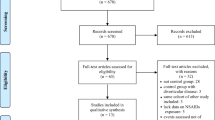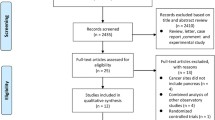Abstract
Lower gastrointestinal bleeding is a frequent cause of hospitalization, particularly in the elderly, and its incidence appears to be on the rise. Colonic diverticular bleeding is the most common form of lower gastrointestinal bleeding and is responsible for 30–40 % of bleeding episodes. Risk factors associated with diverticular bleeding include obesity, hypertension, anticoagulants, diabetes mellitus, and ischemic heart disease. Recent studies have suggested a relationship between usage of non-steroidal anti-inflammatory drugs (NSAIDs) and colonic diverticular bleeding; however, most studies were small with wide confidence intervals. We identified studies by searching the PubMed and Scopus databases (from inception through 31 December 2012) and by searching bibliographies of relevant articles. Summary relative risks (RRs) with 95 % confidence intervals (CIs) were calculated with fixed-effects and random-effects models. A total of six studies (five case–control studies and one cohort study) met inclusion criteria for analysis. Non-aspirin NSAIDs (NANSAIDs) and aspirin were associated with an increased risk of colonic diverticular bleeding (summary RR = 2.48, 95 % CI 1.86–3.31), with moderate heterogeneity among these studies (P heterogeneity = 0.11, I 2 = 44.4 %). Stratification to evaluate the heterogeneity found that both NANSAIDs (summary RR = 2.24, 95 % CI 1.63–3.09; 5 studies) and aspirin (summary RR = 1.73; 95 % CI 1.31–2.30; 3 studies) were associated with the risk of diverticular bleeding. Aspirin/NANSAIDs use was strongly and consistently associated with an increased risk of colonic diverticular bleeding. Further studies are needed to stratify individuals at risk of diverticular bleeding associated with the use of these agents.



Similar content being viewed by others
References
Bass BL, Alvarez C. Acute gastrointestinal hemorrhage. In: Townsend CM, Sabiston DC, editors. Textbook of surgery. Philadelphia: Saunders; 2001. p. 816–35.
Longstreth GF. Epidemiology and outcome of patients hospitalized with acute lower gastrointestinal hemorrhage: a population-based study. Am J Gastroenterol. 1997;92(3):419–24.
Vernava AM 3rd, Moore BA, Longo WE, et al. Lower gastrointestinal bleeding. Dis Colon Rectum. 1997;40(7):846–58.
Gostout CJ, Wang KK, Ahlquist DA, et al. Acute gastrointestinal bleeding. Experience of a specialized management team. J Clin Gastroenterol. 1992;14:260–7.
Lanas A, García-Rodríguez LA, Polo-Tomás M, et al. The changing face of hospitalisation due to gastrointestinal bleeding and perforation. Aliment Pharmacol Ther. 2011;33:585–91.
Ríos A, Montoya MJ, Rodríguez JM, et al. Acute lower gastrointestinal hemorrhages in geriatric patients. Dig Dis Sci. 2005;50:898–904.
Comay D, Marshall JK. Resource utilization for acute lower gastrointestinal hemorrhage: the Ontario GI bleed study. Can J Gastroenterol. 2002;16:677–82.
Lhewa DY, Strate LL. Pros and cons of colonoscopy in management of acute lower gastrointestinal bleeding. World J Gastroenterol. 2012;18(11):1185–90.
Zuccaro G Jr. Management of the adult patient with acute lower gastrointestinal bleeding. American College of Gastroenterology. Practice Parameters Committee. Am J Gastroenterol. 1998;93(8):1202–8.
Hall J, Hammerich K, Roberts P. New paradigms in the management of diverticular disease. Curr Probl Surg. 2010;47(9):680–735.
Wong SK, Ho YH, Leong AP, et al. Clinical behavior of complicated right-sided and left-sided diverticulosis. Dis Colon Rectum. 1997;40(3):344–8.
Strate LL, Liu YL, Aldoori WH, et al. Obesity increases the risks of diverticulitis and diverticular bleeding. Gastroenterology. 2009;136(1):115–22.
Parsa F, Gordon HE, Wilson SE. Bleeding diverticulosis of the colon: a review of 83 cases. Dis Colon Rectum. 1975;18:37–41.
Laine L, Connors LG, Reicin A et al. Serious lower gastrointestinal clinical events with nonselective NSAID or coxib use. Gastroenterology 2003;124(2):288e92.
Foutch PG. Diverticular bleeding: are nonsteroidal anti-inflammatory drugs risk factors for hemorrhage and can colonoscopy predict outcome for patients? Am J Gastroenterol 1995;90(10):1779e84.
Suzuki K, Uchiyama S, Imajyo K, et al. Risk factors for colonic diverticular hemorrhage: Japanese multicenter study. Digestion. 2012;85(4):261–5.
Wells GA, Shea B, O’Connell D, Peterson J, et al. The Newcastle–Ottawa Scale (NOS) for assessing the quality of nonrandomized studies in meta-analyses. 2012. http://www.ohri.ca/programs/clinical_epidemiology/oxford.asp. Accessed 5 Sept 2012.
Greenland S. Meta-analysis. In: Rothman K, Greenland S, editors. Modern epidemiology. 2nd ed. Philadelphia: Lippincott Raven; 1998. p. 643–73.
DerSimonian R, Laird N. Meta-analysis in clinical trials. Control Clin Trials. 1986;7:177–88.
Higgins JP, Thompson SG, Deeks JJ, Altman DG. Measuring inconsistency in meta-analyses. BMJ. 2003;327(7414):557–60.
Egger M, Davey Smith G, Schneider M, et al. Bias in meta-analysis detected by a simple, graphical test. Br Med J. 1997;315:629–34.
Begg CB, Mazumdar M. Operating characteristics of a rank correlation test for publication bias. Biometrics. 1994;50:1088–101.
Stroup DF, Berlin JA, Morton SC, et al. Meta-analysis of observational studies in epidemiology: a proposal for reporting. Meta-analysis Of Observational Studies in Epidemiology (MOOSE) group. JAMA. 2000;283(15):2008–12.
Jansen A, Harenberg S, Grenda U, et al. Risk factors for colonic diverticular bleeding: a Westernized community based hospital study. World J Gastroenterol. 2009;15(4):457–61.
Niikura R, Nagata N, Akiyama J, et al. Hypertension and concomitant arteriosclerotic diseases are risk factors for colonic diverticular bleeding: a case–control study. Int J Colorectal Dis. 2012;27(9):1137–43.
Aldoori WH, Giovannucci EL, Rimm EB, et al. Use of acetaminophen and nonsteroidal anti-inflammatory drugs: a prospective study and the risk of symptomatic diverticular disease in men. Arch Fam Med. 1998;7(3):255–60.
Okamoto T, Watabe H, Yamada A, et al. The association between arteriosclerosis related diseases and diverticular bleeding. Int J Colorectal Dis. 2012;27(9):1161–6.
Tsuruoka N, Iwakiri R, Hara M, et al. NSAIDs are a significant risk factor for colonic diverticular hemorrhage in elder patients: evaluation by a case–control study. J Gastroenterol Hepatol. 2011;26(6):1047–52.
Strate LL, Liu YL, Huang ES, et al. Use of aspirin or nonsteroidal anti-inflammatory drugs increases risk for diverticulitis and diverticular bleeding. Gastroenterology. 2011;140(5):1427–33.
Yamada A, Sugimoto T, Kondo S, et al. Assessment of the risk factors for colonic diverticular hemorrhage. Dis Colon Rectum. 2008;51(1):116–20.
Wilcox CM, Alexander LN, Cotsonis GA, et al. Nonsteroidal antiinflammatory drugs are associated with both upper and lower gastrointestinal bleeding. Dig Dis Sci. 1997;42(5):990–7.
Schafer AI. Effects of nonsteroidal antiinflammatory drugs on platelet function and systemic hemostasis. J Clin Pharmacol. 1995;35(3):209–19.
Meyers MA, Alonso DR, Baer JW. Pathogenesis of massively bleeding colonic diverticulosis: new observations. Am J Roentgenol. 1976;127:901–8.
Bjarnason I, Hayllar J, MacPherson AJ, et al. Side effects of nonsteroidal anti-inflammatory drugs on the small and large intestine in humans. Gastroenterology. 1993;104:1832–47.
Guyatt GH, Oxman AD, Kunz R, GRADE Working Group, et al. What is “quality of evidence” and why is it important to clinicians? Br Med J. 2008;336:995–8.
McGuire HH Jr. Bleeding colonic diverticula. A reappraisal of natural history and management. Ann Surg. 1994;220:653–6.
Jensen DM, Machicado GA, Jutabha R, et al. Urgent colonoscopy for the diagnosis and treatment of severe diverticular hemorrhage. N Engl J Med. 2000;342(2):78–82.
Higuchi K, Umegaki E, Watanabe T, et al. Present status and strategy of NSAIDs-induced small bowel injury. J Gastroenterol. 2009;44(9):879–88.
Maiden L. Capsule endoscopic diagnosis of nonsteroidal anti-inflammatory drug-induced enteropathy. J Gastroenterol. 2009;44(Suppl 19):64–71.
Laine L, Smith R, Min K, Chen C, Dubois RW. Systematic review: the lower gastrointestinal adverse effects of non-steroidal anti-inflammatory drugs. Aliment Pharmacol Ther. 2006;24(5):751–67.
Hale WB. NDSG. Colonoscopy in the diagnosis and management of diverticular disease. J Clin Gastroenterol. 2008;42(10):1142–4.
Fong SS, Tan EY, Foo A, et al. The changing trend of diverticular disease in a developing nation. Colorectal Dis. 2011;13(3):312–6.
Arfwidsson S, Knock NG, Lehmann L, et al. Pathogenesis of multiple diverticula of the sigmoid colon in diverticular disease. Acta Chir Scand Suppl. 1964;342:341–68.
Parks TG. Natural history of diverticular disease of the colon. Clin Gastroenterol. 1975;4:53–69.
Miura S, Kodaira S, Shatari T, et al. Recent trends in diverticulosis of the right colon in Japan: retrospective review in a regional hospital. Dis Colon Rectum. 2000;43:1383–9.
Leung Ki EL, Chan FK. Helicobacter pylori infection and nonsteroidal anti-inflammatory drug use: eradication, acid-reducing therapy, or both? Clin Gastroenterol Hepatol. 2012;10(8):831–6.
Thun MJ, Jacobs EJ, Patrono C. The role of aspirin in cancer prevention. Nat Rev Clin Oncol. 2012;9(5):259–67.
Conflict of interest
The authors declare that they have no conflict of interest.
Author information
Authors and Affiliations
Corresponding author
Rights and permissions
About this article
Cite this article
Yuhara, H., Corley, D.A., Nakahara, F. et al. Aspirin and non-aspirin NSAIDs increase risk of colonic diverticular bleeding: a systematic review and meta-analysis. J Gastroenterol 49, 992–1000 (2014). https://doi.org/10.1007/s00535-013-0905-z
Received:
Accepted:
Published:
Issue Date:
DOI: https://doi.org/10.1007/s00535-013-0905-z




